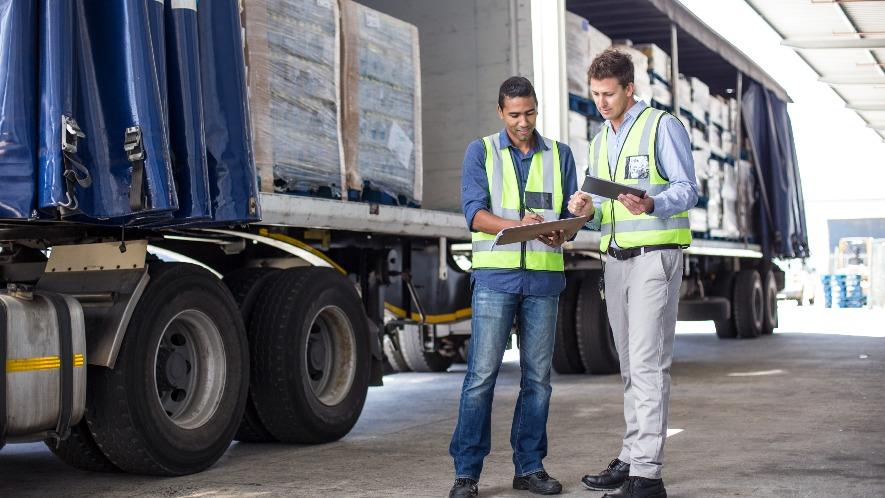The transportation and storage sector is less productive than it was in 2015. Investing in digitalisation and expediting the fuel transition are imperatives, argue PwC’s chief economist Barbara Baarsma and sector specialists of PwC.
As we have mentioned in previous articles, the Netherlands is struggling with labour productivity growth1. While comparable countries with high productivity levels, such as Switzerland, Denmark, Sweden, and the USA are becoming more productive at a fast pace, Dutch productivity growth was barely half of the EU average between 2012 and 2022. In this context, we decided to look deeper into the sectors that might be causing this growth slowdown.
This blog is about the transportation and storage sector. This sector includes all activities related to the transportation of goods and people, as well as the storage of goods. This can include public transportation, freight transportation by road, rail, water or air, as well as storage facilities and distribution centers. While our data covers all these activities, our examples and reasoning are more focused on transportation itself, as opposed to storage activities, although the two are closely related.
Transportation and storage sector less productive than in 2015
The Dutch transportation and storage sector was around 4,3 per cent less productive in 2022 than in 2015. This means that workers in the sector now contribute less per hour worked than they did before. At the same time, productivity in other sectors, such as manufacturing, is higher now than it was in 2015. This is concerning because the transportation and storage sector plays a key role in the Dutch economy.
Besides the fact that it directly employs over 400 thousand people2 in the Netherlands, the transportation and storage sector functions as a support for the whole economy, which is particularly open to trade and foreign players3.
When the transportation and storage sector experiences productivity losses, operating costs might increase for other sectors. This happens because transportation and warehousing costs become higher compared to output, for the same number of hours worked4. A well-functioning, efficient, and productive transportation sector is thus indispensable in today’s day and age.
Why is the transportation sector struggling to become more productive?
When asked what the main obstacle to increasing productivity is, the most common factor pointed out in the transportation and storage sector is the lack of qualified staff (47.8%). This is followed by external factors generating economic uncertainty (22%) and the lack of financial resources (15.6%)5.
- A shortage of people
Labor shortages increase the workload of existing workers and compromise firms’ ability to deliver high-quality services while expanding their offering. In addition, shortages in the transportation and storage sector can spillover to other firms and industries. A shortage of truck drivers can lead to shipping containers remaining in ports for longer periods than necessary. Understaffed warehouses and distribution centres are unable to operate at full capacity, causing delays that result in material or inventory shortages for manufacturers and retailers. The significant increase in e-commerce sales volumes can pose difficulties for understaffed centres to keep up with the high volume of order fulfilment.
The sector struggles to attract sufficient talent. Part of this is due to the image of the professions: working as a truck driver or on board a ship is demanding and requires long periods away from home. The fact that the sector is predominantly male dominated can also discourage young women from applying. Furthermore, companies in the sector may have a reputation for being polluting and environmentally unfriendly, which is a topic that particularly concerns the younger generations entering the workforce6. Changing this image requires a lot of work, which brings us to the next topic.
- The fuel transition is slow
Due to the lack of cost-efficient alternatives, the transportation and storage sector is still heavily reliant on fossil fuels7. In the meantime, the EU wants to cut transportation sector emissions by 90 per cent until 20508. This means that transportation and storage firms must also prioritize compliance with this regulation, as opposed to focusing purely on operational efficiency and productivity.
The transition to eco-friendly fuel is particularly hard in shipping and air transport. Firstly, because, for it to be adopted, the new fuel must be widely available, also in (air)ports in developing countries. Secondly, large investments in ships and planes take time to payoff. Switching to more environmentally friendly fuel means thousands of multi-million-dollar cargo ship and airplane engines would have to be refitted and altered9. This is risky if there is no clarity as to what the fuel of the future is. These coordination problems can delay investment, reducing productivity growth.
Regardless of what fuel is adopted, emissions are an increasing source of costs. As of 2024, the maritime industry is gradually being included in the Emissions Trading System10 (EU ETS), which requires emitting firms to trade emission permits, given a cap to total emissions. Consequently, transitioning to greener fuel automatically involves lower costs in this domain. The road transport sector is currently not included in the EU ETS (Emissions Trading System). The emissions from vehicles such as cars and trucks are mainly regulated through national measures and EU legislation focused on fuel efficiency and CO2 standards for new vehicles. In April 2023, the European Parliament approved the expansion of the ETS emissions trading system to fuels for road transport.
In addition, policies such as the European green bond standard aim to reduce the financing cost of sustainable firms. Essentially, firms that comply with certain ESG requirements will be deemed more sustainable, and hence enjoy cheaper financing through bonds. The issue is that transportation is currently responsible for around a quarter of total greenhouse gas emissions in the EU, which means it is harder to obtain financing. Thus, purely from the perspective of increasing costs, the delayed fuel transition is affecting productivity.
All in all, firms are reluctant to invest beyond what is strictly required by regulation (thus missing out on productivity-boosting investment), even as they face the rising costs of emissions. Uncertainty and risk drive a short-term mindset
The recent (geo)political instability has affected the entire economy, and the transportation and storage sector is no exception. Our supply chain monitor has shown that this puts pressure on the sector worldwide. These developments make it very difficult for companies in the sector to plan for the long term, as they are constantly focused on managing unforeseen circumstances in the short term. This problem is further exacerbated by the fact that transportation is a 'high volume, low margin' business11, which limits investment capacity.- Digitalisation and automation are lagging behind
The sector was slow to digitalise, thereby failing to capitalize on technological improvements that can significantly boost productivity. The perceived high costs and lack of standards are a barrier to digitalization. Adoption of digital transformation has been cautious particularly in sea and air freight12. Although self-driving vehicles are a real possibility, for instance, ships, trucks and planes are still largely operated by people.
Besides automation, digitalization of management systems is unavoidable in the context of the requirements for sustainable reporting CSRD13, which requires tracking environmental information and achievements across the production process. This can only be achieved with efficient, digital software, capable of managing large volumes of data.
Furthermore, the more practically trained human capital that is employed by the Transportation and Storage sector is not particularly well prepared for changing processes, work environments, and technologies, which is another important factor when it comes to labour productivity14.

How can we increase the productivity of the transportation sector?
- More automation and digitalisation
The fact that the transportation and storage sector is lagging means that there are plenty of opportunities to be taken advantage of. We consider it imperative that the transportation and storage sector keep looking for more ways to automate and digitalise processes, thus mitigating labour shortages and boosting productivity15. Among many others, some areas to consider are the utilisation of robots in warehouses, as well as drones, automated vehicles for deliveries, and the use of blockchain technology in smart contracts. The use of digital resources allows for a better understanding and prediction of customers' desires, as well as their customers' wishes, with greater precision. All these developments facilitate efficiency, by ensuring that productive capacity is employed where it is most needed.
Collaboration to accelerate the fuel transition
Since this can only be done collectively, companies in the sector need to join forces to accelerate the transition to a fuel system. Firstly, it will make the sector more attractive to potential employees, reducing labour shortages. Secondly, it will reduce emissions and related costs, promote regulatory compliance, and possibly even provide cheaper financing. Thirdly, it will be a driving force for a more sustainable and greener economy.
While some companies are making significant efforts to become more attractive and environmentally friendly, their stories are not effectively communicated and overshadowed by other, more negative messages. A greater effort from a broad group of companies can yield better results and a more convincing narrative.
Improving operational excellence
In addition to automation and digitalisation, investments in operational excellence can also contribute to increased productivity. More effective use of personnel and better performance management are essential. We have developed a methodology that increases productivity within a few months while also improving employee motivation and engagement. This not only increases capacity in the warehouse or in the logistics chain but also positions companies as attractive employers in the labour market.
Learn more about our Perform method for increasing productivity and engagement
1 Labour productivity is a measure of the efficiency with which work is performed. For the economy as a whole, this is the gross domestic product (at market prices) divided by the volume of labor. For sector labor productivity, gross value added at basic prices is used instead of GDP. The volume of labor is measured in terms of the number of hours worked or, alternatively, the number of labor years or (less accurately) the number of employed persons.
2 https://opendata.cbs.nl/statline/#/CBS/en/dataset/81156eng/table?ts=1710340802838
3 https://data.worldbank.org/indicator/NE.TRD.GNFS.ZS?locations=NL-1W
4 https://ops.fhwa.dot.gov/freight/documents/freightstory_12902.pdf
5 Three-quarters of entrepreneurs are trying to increase productivity | CBS
6 https://www.pewresearch.org/science/2021/05/26/gen-z-millennials-stand-out-for-climate-change-activism-social-media-engagement-with-issue/
7 https://understand-energy.stanford.edu/energy-services/energy-transportation
8 https://www.nortonrosefulbright.com/en-nl/knowledge/publications/c50c4cd9/the-eu-green-deal-explained
9 https://www.cbc.ca/news/world/global-shipping-emissions-1.6636413
10 https://www.naturvardsverket.se/en/guidance/eu-emissions-trading-system-ets/maritime-transport-in-the-eu-emissions-trading-system-ets/#:~:text=The%20maritime%20sector%20will%20be,emissions%20caused%20by%20the%20voyage
11 https://www.kimnet.nl/binaries/kimnet/documenten/notities/2023/03/30/kostenkengetallen-voor-het-goederenvervoer/Cost+figures+for+freight+transport_def.pdf
12 Kern, J. (2021). The digital transformation of logistics: A review about technologies and their implementation status. The digital transformation of logistics: Demystifying impacts of the fourth industrial revolution, 361-403.
13 https://finance.ec.europa.eu/capital-markets-union-and-financial-markets/company-reporting-and-auditing/company-reporting/corporate-sustainability-reporting_en
14 Fox, J. T., & Smeets, V. (2011). Does input quality drive measured differences in firm productivity?. International Economic Review, 52(4), 961-989.
15 Sardarabady, N. J., & Durst, S. (2024). A systematic literature review on the economic impact of digitalization technologies in transport logistics. Transport Economics and Management.



















